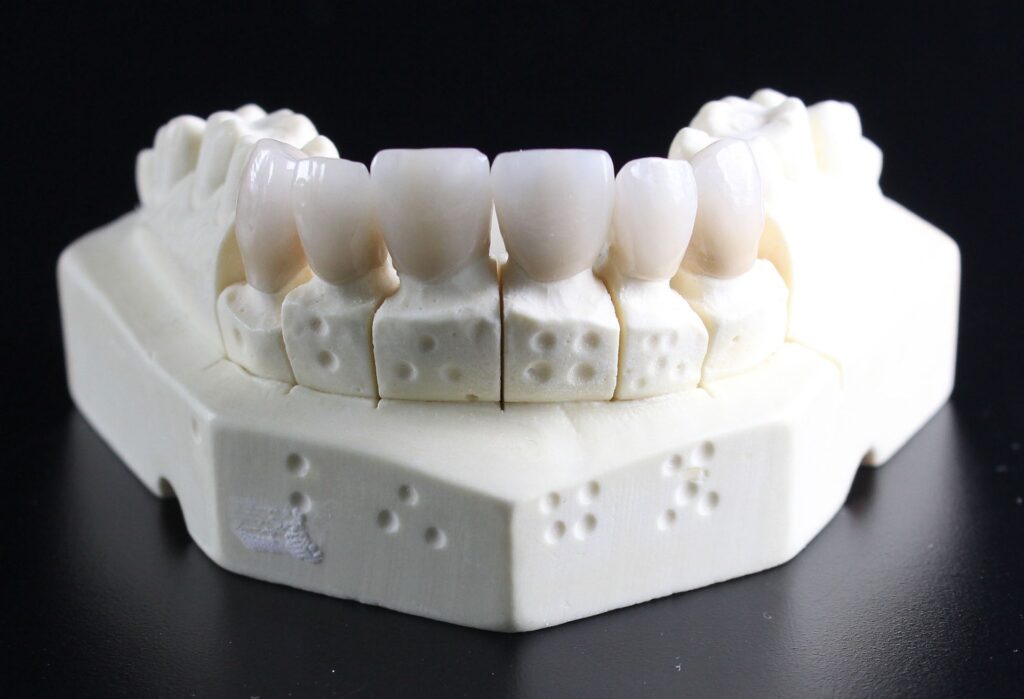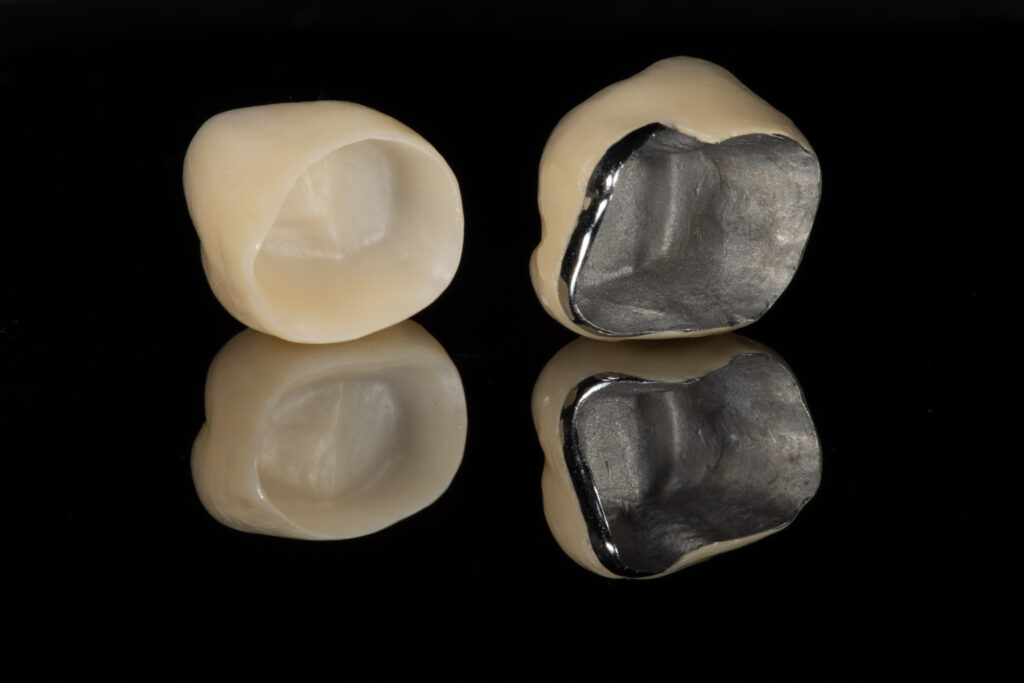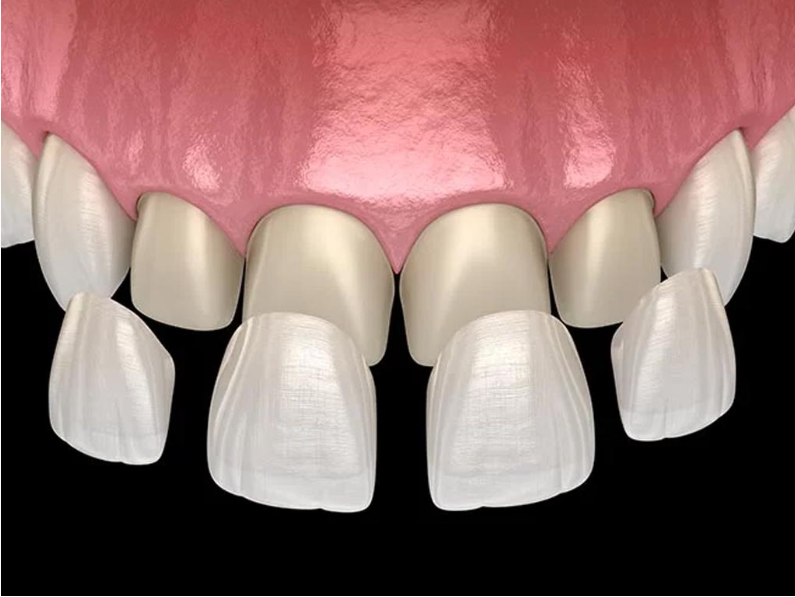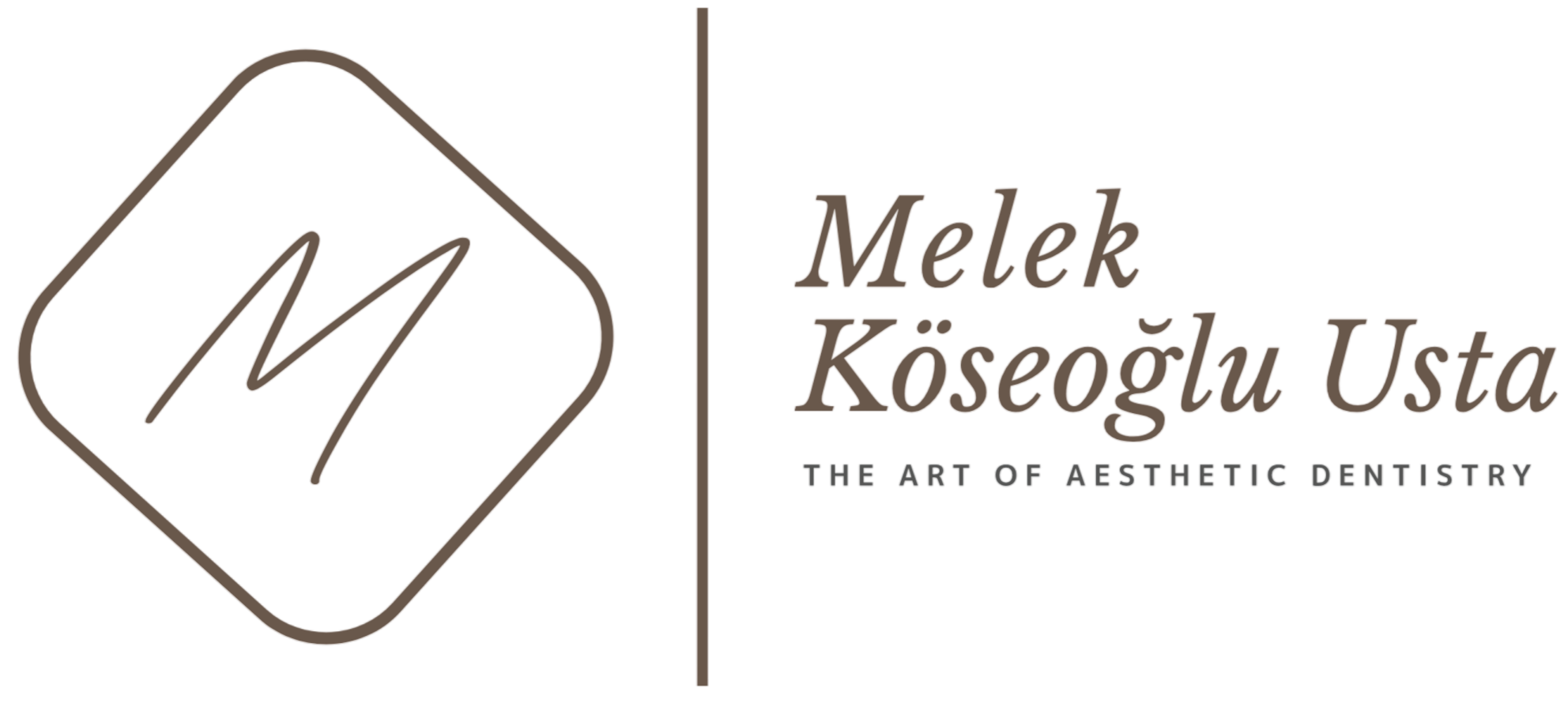What is Zirconium Crown?
Dental crowns are used to cover a tooth or dental implant. Dentists often use crowns to support broken, weak, or misshapen teeth. They may also be used in conjunction with bridges to strengthen multiple teeth. When it comes to the materials used to make crowns, there are several options, including ceramic and metal. Another option is zirconium veneers. Although zirconium crowns are classified as a type of ceramic crown, they are made from zirconium dioxide, an extremely durable type of metal related to titanium. Zirconium crowns are a dental restoration option used in dentistry. Zirconium is a white, durable, and strong material used to improve the appearance and strength of the tooth structure. The crown covers the entire upper part of the tooth, closing cavities or fractures and improving the tooth’s strength and natural appearance.
Zirconium Crown
Contents
What is zirconium coating? What are the stages of zirconium coating?
In classic metal-supported crowns and the substructure of bridge prostheses, the grey metal traditionally used has increasingly been replaced by a white alloy called zirconium. Zirconium is extremely durable and, unlike metals, resistant to corrosion, so it has a wide range of applications in dentistry beyond crowns and bridges.
Zirconium teeth are a restoration material used in dentistry. They are made from zirconium oxide material and are used to replace damaged, decayed or diseased parts of teeth. Due to their durability, strength and aesthetic appearance, they are used as an alternative to traditional metal and porcelain dental crowns, especially on the front teeth. Zirconium is a natural material that is highly resistant, does not cause allergic reactions, maintains colour integrity, and eliminates hot-cold sensitivity. It has been frequently used in aesthetic and prosthetic treatments in recent years. Zirconium, a highly durable and aesthetic material, is used to cover tooth surfaces, and this process is called zirconium dental veneering. Also known as crowns, zirconium dental veneers are quite popular as they enable aesthetic prosthetic treatments. Being a translucent and durable material, zirconium, combined with the advantage of its white colour, guarantees white teeth and an aesthetic smile as a result of decayed tooth restoration.
- Firstly, if the patient has any other dental problems, these should be treated.
- Then, a small amount of grinding should be done on the teeth to be crowned to ensure that the crowns fit perfectly.
- After the necessary grinding has been done, impressions should be taken of the teeth and transferred to a digital environment
- The order for the teeth with the specified measurements should be sent to the laboratory and temporary crowns should be applied to the patient.
- Zirconium veneers arrive in approximately one week.
- Once the actual zirconium veneers are ready, the temporary veneers should be removed and the zirconium dental veneers applied to the teeth.
- To ensure the crowns fit perfectly with the teeth, final adjustments should be made and the crowns should be bonded to the teeth.
- This makes it possible to free the patient from the appearance that causes them discomfort and provide them with a healthier and more aesthetic smile.
Zirconium is frequently used in dentistry; however, as not all zirconium is of the same quality, care should be taken to use zirconium blocks approved by the World Health Organisation during application. The use of low-quality zirconium blocks can lead to adverse health effects for the patient. Zirconium blocks can be produced in varying qualities by different brands. A meticulous approach should be taken to ensure the use of zirconium blocks approved by the WHO in order to achieve the healthiest and most effective results.
Tooth Preparation
The dentist removes the damaged or decayed part of the tooth, then shapes the remaining tooth structure and prepares it to provide a suitable fit for the crown.
Impression & Production
The dimensions of the extracted tooth are taken digitally or with silicone, and the patient is discharged after temporary teeth are fitted. Based on the measurements taken, a crown is manufactured in the laboratory from zirconium oxide material using CAD-CAM and milling technologies.
Testing and Finishing
After the tooth from the laboratory has been tried in the patient's mouth and no problems are found, it is cemented onto the patient's prepared tooth using dental cement materials.
What are the Advantages of Zirconium Crown?
There are numerous advantages to choosing zirconium dental veneers. We have touched upon these advantages throughout our article, but to summarise them broadly, they are as follows:
- Zirconium dental crowns are currently recognised as one of the most natural and realistic types of crowns in the dental industry. Particularly appealing to patients who are hesitant about having crowns fitted due to aesthetic concerns, zirconium crowns offer a natural and realistic appearance that is almost indistinguishable from natural teeth.
- The zirconium dental veneer application consists of a simple design. The ceramic components fitted after the application offer the patient long-lasting use, as they carry no risk of coming loose or shifting.
- A significant number of people are allergic to metals, but as zirconium does not contain any metal, there is no possibility of it causing a metal allergy reaction. Zirconium is a type of coating that can be safely chosen by those allergic to metals and similar components, and it is one of the most important coating materials recommended for such sensitivities.
- Zirconium crowns are incredibly strong and durable. The long-term success rate of zirconium dental crown treatment is very high, and this is the most satisfying advantage for those who choose this type of crown. Zirconium crowns are designed to withstand high pressure and can endure for a long time without showing even the slightest damage, even against high resistance.
- Many patients prefer zirconium dental crowns because they promise comfortable and convenient use. Produced in a three-dimensional manner in a computer environment, zirconium dental crowns offer a shorter treatment period and provide the patient with a high degree of comfort and ease during daily use.
- The human body does not reject zirconium. For these reasons, the likelihood of infection, complications, pain and allergic reactions due to crowns is reduced.
- It is more effective than porcelain in covering tooth damage caused by staining or fractures. It is strong enough to withstand the most intense biting and chewing activities. It is resistant to extreme heat and cold. It is durable and long-lasting as it is resistant to chipping and cracking.
- The disadvantages of zirconium crowns are minimal compared to their advantages. They are not suitable for use when the patient has multiple adjacent missing teeth. They are also more expensive than metal-supported crowns.
What Should Be Considered Before and After Zirconium Crown Treatment?
High-quality materials must be used in the manufacture of zirconium veneers, and the person’s mouth and teeth measurements must be taken correctly. Otherwise, the tooth with the zirconium veneer may be too high or too low. In this case, the jaw may not close properly, causing problems when eating and speaking. Incorrectly made zirconium veneers can lead to decay or breakage of the underlying teeth. The first thing to consider is having this treatment done by the right hands.
One of the most common questions many patients have about zirconium dental veneers is, ‘Do zirconium dental veneers cause pain?’ Local anaesthesia is administered to the patient before the procedure, which prevents the patient from feeling any pain or discomfort during the procedure. Considering the advantages of zirconium dental veneers, the benefits gained by having this procedure done are maximised. There are very few things you need to pay attention to before and after the zirconium application, and it is easy to apply. As the treatment is short and usually completed within a few days, you will not experience any aesthetic concerns, and you can resume your life as normal once your treatment is complete. If there are no medical issues with your teeth or gums, your treatment process can be completed in as little as one week. On the day the zirconium crown is fitted and for the following week, you should avoid consuming extremely cold or hot food and drinks, and take care not to eat sticky or hard foods. If your dentist has requested a follow-up appointment, you should not miss it. The adjustment period for zirconium dental crowns varies from person to person, but most of our patients report that within 5 to 10 days, they feel as if there is nothing on their teeth and that they have adapted to the zirconium crown very quickly.

What is the Cost of Zirconium Crowns and What Factors Does it Depend On?
Zirconium dental crown prices are primarily determined by factors such as the number of teeth you plan to have crowned, the purpose of the crown, and whether the patient will undergo any other treatment before or after the zirconium crown. The quality of the zirconium used, the laboratory workmanship, and the skill of your dentist are other factors that can affect the price. If you live in Istanbul and want to have zirconium veneers made by the best dentists for your teeth, you can visit our dental clinic in Kartal and achieve your dream teeth and smile in the shortest time possible.
When is Zirconium Crowns Preferred?
- Teeth with discolouration, such as those that have turned grey or yellow.
- Closing gaps between teeth for aesthetic purposes.
- Teeth that are crooked or not in their proper position.
- Teeth that need to be covered in smile aesthetics treatments.
- Teeth with too much material loss to be filled.
What are the differences between zirconium and metal-supported porcelain?

Understanding the differences between metal-supported crowns and zirconium crowns in dental treatment is one of the topics of interest for those who are considering having their teeth crowned. There are a number of differences between metal-supported crowns and zirconium crowns, which are two distinct methods of dental crowns.
- Durability: The standout feature of metal-supported porcelain teeth is their strength and suitability for use as bridges in large toothless areas. For example, if you have more than two missing teeth and a bridge is planned, metal-supported porcelain teeth are preferred. This is due to their robust structure and ability to maintain resistance over a long period.
- Aesthetics: Zirconium is, in short, a white-coloured metal. It possesses many of the properties associated with the concept of metal. It has a superior aesthetic structure and is more biocompatible. In terms of natural appearance, it offers a more successful look than porcelain teeth.
- Tissue Compatibility: Zirconium dental crowns are far superior in terms of aesthetic appearance, tissue compatibility and naturalness. Of course, it should not be forgotten that there are many quality options for zirconium. Provided that planning and measurements are done well, they are difficult to break when very long bridges are not made. More vibrant, natural results are achieved.
- Light Transmission: Metal-supported veneers are not light-transmitting. Their colours are cooler and more matt compared to zirconium crowns.
- Gingival Reflection: Metal-supported veneers use metal (grey) bridges to support the ceramic that will form the tooth shape. In zirconium veneers, this layer is white and does not create a dark reflection from the gums. It transmits light.
- Front Region Use: Zirconium veneers and other aesthetic veneers, laminates are generally used in cases of diastema (gap between two teeth) occurring in the front teeth, teeth with malformation, broken or worn teeth, and poor tooth colour changes. The use of metal-supported veneers, especially on front teeth, is decreasing day by day. Zirconium veneers, which are more aesthetically similar to natural teeth, can be applied to both front and back teeth. Your dentist will be best placed to decide which option is suitable for you.
- Excessive Tooth Reduction: Metal-supported veneers may reflect the opaque colour of the underlying metal support. If we wish to avoid this opaque reflection, excessive tooth reduction is required. With materials such as zirconium available, it is preferable to use aesthetic veneers rather than excessive tooth reduction. This may result in a dull appearance on the teeth. However, zirconium, which is semi-metallic, allows light to pass through, enabling the tooth to reflect its own colour. Veneers made with a metal backing require more tooth reduction. With zirconium veneers, there is less tooth loss. This provides a more minimally invasive and healthier result.
- Dark Gum Line: In teeth with metal crowns, problems such as colour reflection from the gums due to gum recession may occur over time. Zirconium veneers provide high compatibility with the gums and can be used for many years.
- Cost: Metal-supported porcelain veneers are less expensive than zirconium veneers.
- Lifespan: Well-made veneers provide long-lasting results. It is not entirely accurate to state that zirconium veneers are definitely more durable, but they are much more suitable for gum and oral health.
- Use in Implant-Supported Prostheses: A metal framework may be preferred in implant-supported full-arch prostheses such as All-on-Four. As there is more space available for porcelain placement, it is possible to achieve aesthetic results with these prostheses as well.
What are the differences between zirconium-supported prostheses and E-Max (all-ceramic) porcelains?

Both options are highly biocompatible treatments that we use with confidence in cosmetic dentistry applications. The methods we frequently use in our treatments enable us to achieve natural-looking teeth with high aesthetic value. Their common feature is that they do not contain any metal-type materials that could cause aesthetic problems and are produced using advanced systems to achieve the desired results.
- Durability: Zirconium coatings differ in terms of their underlying structure and are preferred when high resistance is expected in addition to aesthetics. In other words, if you have a toothless gap and a bridge is planned, a full ceramic bridge cannot be made, and zirconium is preferred. Again, we avoid full ceramics in those with high force and a tendency to clench their teeth.
- Aesthetics: For front teeth, if there are no missing teeth, all-ceramic restorations are preferred.
Please remember that your doctor will determine the most suitable treatment plan for you in this regard.
Zirconium Crowns (Natural and Durable)
We restore a natural appearance to broken, discoloured or misshapen teeth using zirconium veneers that closely match tooth colour and texture. We aim for long-lasting results through precise measurements and modern production techniques. Let us determine the most suitable type of veneer for you during your consultation.
How Long Do Zirconium Teeth Last?
The lifespan of zirconium dental crowns varies between 5 and 15 years, but with excellent care, this period can be extended up to 20 years.
Do zirconium teeth discolour?
Zirconium teeth have a smooth and slippery surface. For this reason, plaque does not accumulate on them. As a natural consequence, zirconium teeth are not affected by foods that can cause staining and do not change colour.
Do Zirconium Teeth Hurt?
Following zirconium dental treatment, some discomfort may be experienced for the first few days, depending on the individual’s sensitivity. This condition resolves itself within a short period of time.
Can Zirconium Teeth Break?
Zirconium is an extremely durable material that does not break easily. However, individuals experiencing health issues that damage their teeth, such as bruxism, should seek treatment for these problems first. It is also beneficial to avoid biting very hard foods and objects after zirconium coating.
Zirconium? Laminate Teeth?
To decide whether zirconium or laminate porcelain is more suitable, patients’ complaints and oral conditions must be evaluated. Zirconium is a procedure that can be completed in a shorter time. While zirconium surrounds the tooth completely, laminate porcelain is applied to only one surface of the tooth.
Metal-Supported Teeth? Zirconium Teeth?
Zirconium teeth are produced using refined technologies, allowing them to be easily placed on the teeth and fit well. As a result, they provide effective protection for the teeth. Compared to metal-supported crowns, zirconium stands out due to this feature.
Zirconium Crown? Or E-max All-Ceramic Crown?
Both options are treatments with high biological compatibility that we use with confidence in aesthetic dentistry applications. Using the methods we frequently employ in our treatments, we can achieve natural-looking teeth with high aesthetic value. Their common feature is that they do not contain any metal-type material that could cause aesthetic problems and are produced using advanced systems to achieve the desired results. Zirconium veneers differ in terms of their underlying structure and are preferred if high resistance is expected in addition to aesthetics. In other words, if you have a toothless gap and a bridge is planned, a full ceramic bridge cannot be made, and zirconium is preferred. Similarly, we avoid full ceramics in cases of high force and teeth grinding tendencies in molars. In the front teeth, however, full ceramics are preferred if there is no tooth loss.
How to Clean Zirconium Crowns?
To ensure zirconium teeth last a long time, teeth should be brushed at least twice a day. Dental floss should be used to clean food debris stuck between teeth. Food debris trapped under zirconium veneers should also be removed. Even with regular brushing and flossing, if food debris cannot be removed, mouthwash should be used twice a day.
